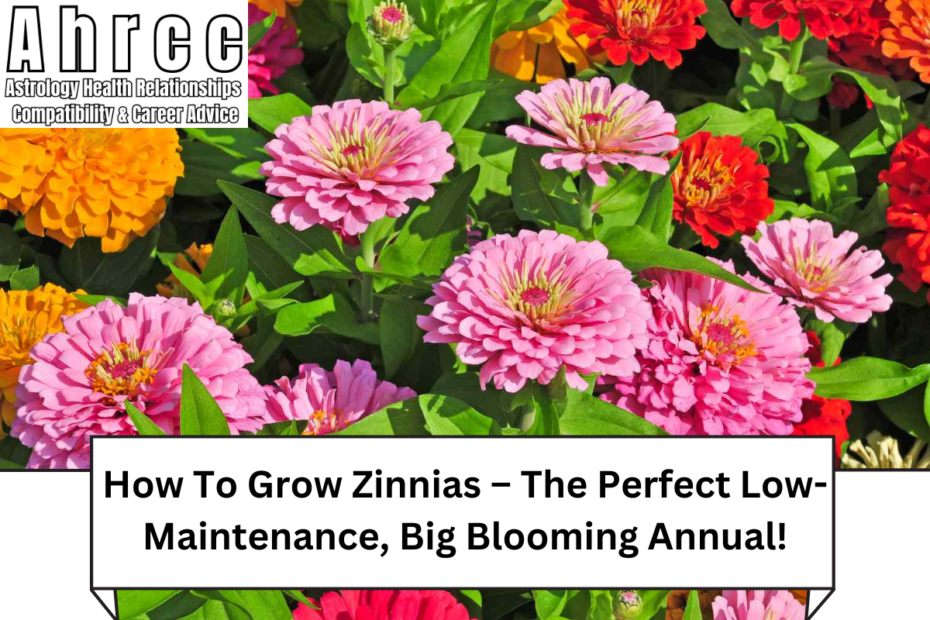How To Grow Zinnias – The Perfect Low-Maintenance, Big Blooming Annual!: Zinnias are vibrant, easy-to-grow annual flowers known for their large, showy blooms and ability to thrive with minimal care. Their bright colors and long blooming season make them a favorite among gardeners, from beginners to seasoned experts.
Zinnias can easily transform any garden with their bold, eye-catching beauty, and they attract beneficial pollinators like bees and butterflies. Whether you want to plant them in garden beds or containers, zinnias are a perfect choice for a low-maintenance, high-impact garden display.
Why Choose Zinnias?
Low Maintenance: Zinnias are known for being one of the easiest flowers to grow. They thrive in various soil conditions and require little attention once established.
Drought Tolerant: Zinnias can tolerate dry spells, making them an excellent choice for gardens in hot climates.
Attractive Blooms: Zinnias produce large, colorful blooms that range from red, pink, and yellow to white, purple, and orange. Some varieties can grow up to 4 feet tall, with flowers as wide as 5 inches.
Long Blooming Period: Zinnias bloom from early summer until the first frost, providing long-lasting color throughout the season.
See Also:How To Grow Snapdragons – The Unique Flower With Hinged Blooms
Step-by-Step Guide to Growing Zinnias
1. Choosing the Right Zinnia Variety
There are several types of zinnias to choose from, depending on your garden space and design preferences. The most popular varieties include:
- Zinnia elegans: Known for their large, dahlia-like blooms, they can grow up to 4 feet tall.
- Zinnia angustifolia: These compact plants have smaller, daisy-like flowers and are ideal for borders or containers.
- Zinnia haageana: A more heat-tolerant variety, with smaller, more delicate blooms, perfect for hot, dry climates.
Choose varieties based on your space and the look you’re aiming for. Taller zinnias make great backdrops or centerpieces, while dwarf varieties are perfect for edging or container gardening.
2. Planting Zinnias
When to Plant: Zinnias are warm-weather plants that thrive in the heat. It’s best to plant them after all danger of frost has passed, typically in late spring or early summer.
Starting from Seeds: Zinnias can be directly sown in the garden or started indoors. If starting indoors, plant seeds 4-6 weeks before the last frost date. Plant the seeds 1/4 inch deep in seed trays or pots. Keep the soil moist and in a warm, sunny location for the seeds to germinate.
Direct Sowing in the Garden: To direct sow zinnias, plant the seeds 1/4 inch deep in well-prepared soil after the last frost. Space the seeds 6-18 inches apart, depending on the variety. Keep the soil moist until the seeds germinate, which usually takes 5-10 days.
3. Soil and Sunlight Requirements
Zinnias are not picky about soil, but they grow best in well-draining soil rich in organic matter. Adding compost or well-rotted manure can improve soil fertility.
They thrive in full sun, requiring at least 6 hours of sunlight daily to produce abundant blooms. Planting zinnias in full sun also helps prevent fungal diseases like powdery mildew, which can affect the plants in shady, humid conditions.
4. Watering and Care
Once zinnias are established, they require minimal care. Water them deeply but infrequently, allowing the soil to dry out between waterings. Overwatering can lead to root rot and fungal diseases. If you live in an area with frequent rain, you may not need to water your zinnias at all.
- Mulching: Applying a layer of mulch around the base of the plants helps retain moisture, reduce weed growth, and regulate soil temperature.
- Fertilizing: Zinnias are light feeders and don’t require much fertilization. A light application of balanced, slow-release fertilizer at planting time is usually sufficient. Over-fertilizing can cause lush foliage but fewer blooms.
5. Deadheading for Continuous Blooms
To encourage continuous blooming, deadhead (remove) spent flowers regularly. This prevents the plant from going to seed and redirects its energy toward producing more blooms. Simply snip off the faded flowers just above a pair of leaves or buds.
6. Pests and Diseases
Zinnias are relatively pest-resistant but can occasionally attract aphids, spider mites, or whiteflies. If you notice these pests, spraying the plants with insecticidal soap or neem oil can help control the problem.
As for diseases, powdery mildew can be an issue, especially in humid climates. To prevent this, ensure good air circulation around the plants by spacing them properly and watering at the base to keep the leaves dry.
Growing Zinnias in Containers
Zinnias are excellent container plants, especially dwarf varieties. Use well-draining potting soil in a container that has drainage holes. Place the container in full sun and water when the top inch of soil feels dry. Regular deadheading and light fertilization will keep your zinnias blooming throughout the season.
Companion Planting with Zinnias
Zinnias are great companions for many other garden plants. They attract pollinators like bees and butterflies, which can help with the pollination of nearby plants like tomatoes, cucumbers, and squash. Zinnias can also act as a trap crop, luring aphids and other pests away from your vegetables and other flowers.
Harvesting Zinnias for Cut Flowers
Zinnias make beautiful cut flowers that last up to a week in a vase. To harvest, cut the stems in the morning when the flowers are fully open. Choose blooms with firm stems and remove any leaves below the waterline to prevent bacterial growth. For longer-lasting arrangements, change the water daily and trim the stems every few days.
Conclusion
Zinnias are the perfect low-maintenance, big-blooming annuals for gardeners of all skill levels. Their bright colors, resilience, and long blooming season make them an excellent addition to any garden or container.
Whether you’re looking to fill garden beds, create a pollinator-friendly landscape, or enjoy vibrant cut flowers indoors, zinnias are a dependable and beautiful choice. With a little sun and occasional care, these flowers will reward you with months of stunning blooms.
